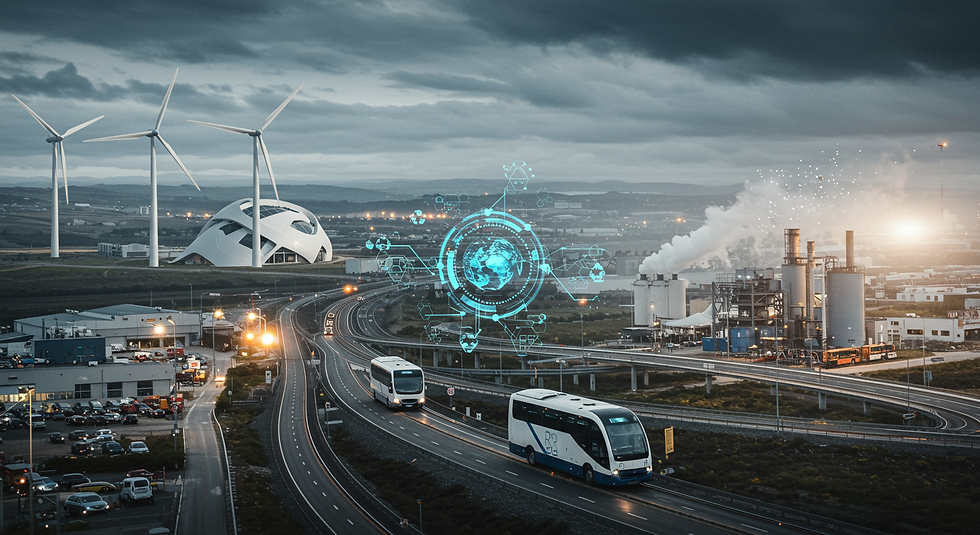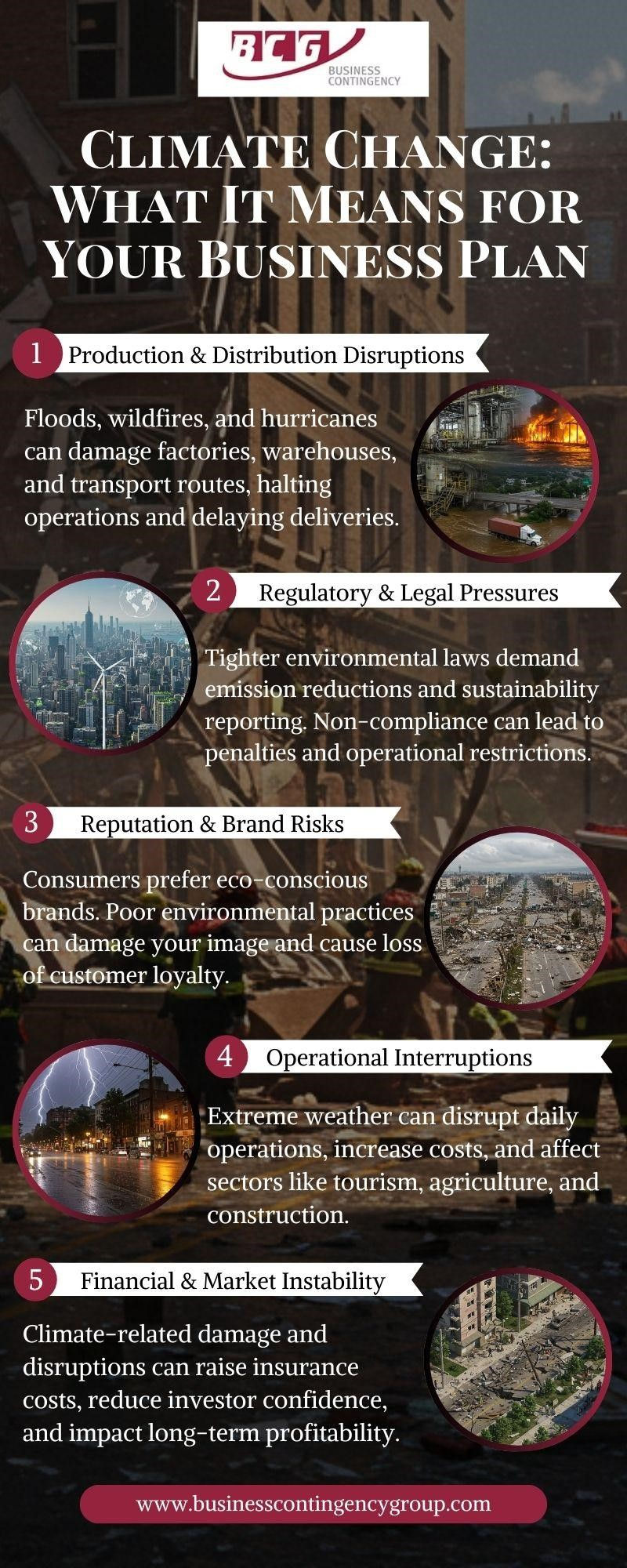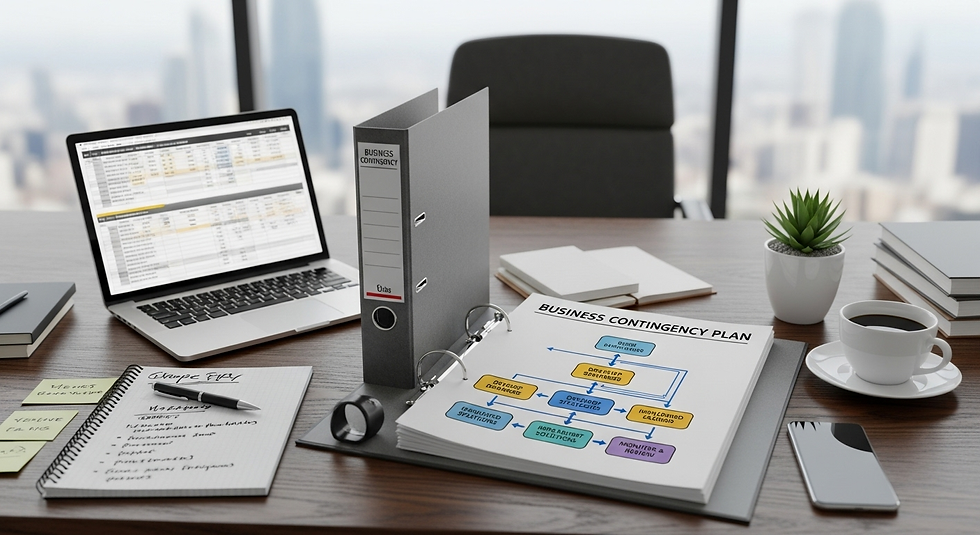Climate Change: What It Means for Your Business Plan
- rebekahh84
- Aug 13
- 7 min read

Climate change is one of the biggest challenges to society. According to a survey by Edelman Trust Institute, 93% of global respondents believe that climate change can pose a serious threat to the planet.
Floods can shut down the entire supply chain, and wildfires can impact the business through operational disruption.
The impact of climate change is not only felt on the planet but is felt across all industries. That is why, as a business leader, it is important to create an informed organizational strategy that can help to mitigate risks.
Yet, there are many businesses that treat climate change as a distant concern and sometimes they expect the government and future leaders to solve it.
In this post, we will explore how climate change is reshaping the industry and how business leaders can transform uncertainty into opportunity.
Understanding the Impact of Climate Change on Business Operations
Climate change is not just an environmental issue, but can also pose a direct business challenge that can disrupt:
• Operations
• Supply chains
• Long-term growth.
Extreme weather events like floods, hurricanes, and wildfires can halt production and hinder any business continuity planning. Here is how a business continuity plan can impact your business.
1. It impacts the Production and Distribution of Goods and Services
Climate change events such as floods, wildfires, and hurricanes can severely damage factories and warehouses. Urban centers produce goods that are important on local and global scales.
A network of interconnected systems keeps goods and services moving smoothly. Climate change poses a threat to the stability of these systems in many ways. For example, severe weather can cause power outages that stop transportation and make it hard to get to essential services like healthcare.
2. Regulatory and Legal Risks
Governments and regulatory bodies are tightening environmental standards as climate change has become a priority on global agendas.
Regulatory and legal risks can greatly affect businesses, especially those in energy-intensive industries. New policies may require strict emission limits and mandatory sustainability reporting.
Companies that fail to comply may face legal penalties and even operational restrictions. Global supply chains mean businesses must effectively deal with complex international regulations.
A company that buys raw materials from more than one country might have to deal with different environmental rules. This can make it harder to get the materials and increase the cost. You can avoid legal problems and show consumers and other stakeholders that your business is responsible by following these new rules now.
3. Reputation and Brand Risks:
People are more aware of climate change and this is changing what consumers expect. Many customers now prefer brands that demonstrate a commitment to sustainability and environmental preferences.
Companies can have problems with their reputation and brand if people think they are not environmentally responsible or resistant to change.
Social media makes these perceptions more common, and it makes it easier for bad news to spread quickly. Sustainability these days has become a key factor that sets some businesses apart from their competition.
Reputational and brand risks can threaten a good name and potentially lead to decreased revenue and diminished market value.

4. Operational Risks from Climate Change
Climate is a major risk for many businesses across the globe. Changes in climate patterns can disrupt the day-to-day operations that may not be visible immediately, and these effects can add up over time. Extreme weather can disrupt shipping and transportation, leading to increased energy costs. The weather can directly impact sectors such as tourism, agriculture, and construction. To ensure operational continuity, businesses must incorporate climate forecasts into their strategic planning processes.
5. Financial Risks and Market Instability:
Severe climate events can also directly impact the financial performance of the company and the stability of the market. Some of the common financial impacts are:
· Damage to property
· Interruption of business operations
· The cost of repairs
Climate change can make investors worry, and these investors start to look at companies based on how they treat their employees and behave in the community.
Companies that don't deal with climate risks may have a harder time getting funding or may have to pay more to borrow money.
If your organization does not manage risk well, then you might lose money because of climate change. This could make your business unable to survive in the long term.
6. Long-Term Strategic Considerations
Adapting to climate risks has become a key part of the long-term plan of companies. Companies that are looking to the future are including climate risk assessments in their plans for continuing their businesses.
Businesses are also working with environmental organizations and joining industry-wide efforts to reduce emissions. The goal is to both reduce risks and take advantage of new opportunities as we transition to a low-carbon economy.

How should businesses respond to climate risks?
Climate change is a major transition to business that can impact a company in different proportions of these risks, such as physical, transitional, and liability risks. Businesses can deal with climate risks in a proactive way that is part of their overall strategy. Here is how they respond:
1. Conduct a climate risk assessment:
The first thing a business needs to do is to find out and evaluate specific climate-related risks that they may face, such as extreme weather and supply chain vulnerabilities. Understanding these will help them make informed choices.
2. Integrate Climate into Strategic Planning:
Climate considerations must be embedded into core business strategies and continuity plans.It is important to consider the climate when making decisions. Instead, it needs to be a part of the long-term and daily plans of the organization. It means that your business must update the way it manages risk and set clear sustainability goals.
Businesses should also make sure they are following new rules and international agreements about the environment. This will help them avoid legal and financial penalties.
3.Develop Crisis and Continuity Plans
Businesses need to prepare for the reality that climate events will occur. Detailed crisis and continuity plans help ensure that critical functions can continue during a disaster. These plans should outline clear roles and recovery steps. Conducting the regular drills and simulations will test these plans and reveal any weaknesses that need fixing before an actual emergency happens.
4.Train and Empower Employees
Your employees are the first line of defense during a crisis. Businesses need to ensure that they provide their employees with regular training on climate risk awareness, emergency procedures, and sustainable practices that equip the workforce to respond effectively. Empowered employees can make informed decisions that protect both people and operations.
5.Businesses should respond to climate risks.
We need to take action now and think about it as part of our overall plan to deal with climate change. Climate change is no longer something in the future. Weather events, new rules, and changing what customers want are already affecting businesses around the world. Companies that prepare now can avoid big problems and turn these challenges into chances to grow and create new things.

6.Conduct Climate Risk Assessments
The first step is understanding the specific climate-related risks a business face. These could include extreme weather events like floods, storms, and heatwaves. Businesses should carry out detailed assessments to find out the vulnerable assets, operations, and markets. This data driven approach allows leaders to prioritize resources and make informed decisions about investments and contingency measures.
7.Integrate Climate into Strategic Planning
Climate considerations should not be treated as a side project. Instead, they need to be embedded into the strategic and operational planning of the organization. It means updating risk management frameworks to incorporate climate forecasts into decision-making. Businesses should also ensure alignment with emerging regulations and international climate agreements to avoid legal and financial penalties.
8. Develop Crisis and Continuity Plans
Businesses need to get ready for the fact that climate events will happen. Having good plans for dealing with crises can make sure that important functions continue during a disaster. These plans should clearly define the roles of each team member, the methods of communication, and the steps to take if something goes wrong. Regular drills and simulations will test these plans and show any problems that need to be fixed before an actual emergency happens.
9. Embrace Innovation and Sustainability
Transitioning to sustainable business models reduces exposure to climate risks and improves the market competitiveness. This could mean adopting low-carbon technologies, developing eco-friendly products, or investing in energy-efficient processes. Businesses that lead in sustainability often attract environmentally conscious consumers, investors, and partners. In many cases, innovation in this area also results in cost savings and operational efficiencies.
10. Train and Empower Employees
Employees are a first line of defense during a crisis of the company . Providing regular training on climate risk awareness, emergency procedures, and sustainable practices equips the workforce to respond effectively. Empowered employees can make informed decisions that protect both people and operations.
Businesses can protect themselves from problems related to the climate and create long-term value by taking these steps. A strong plan to deal with climate change not only reduces risks but also makes companies leaders in sustainability. This can be a big advantage over other companies in the years ahead.
Conclusion:
Climate change is no longer a distant environmental concern but a core part of how businesses must plan and grow. One of the deeper questions lies in how your business will redefine success in a world where resilience and sustainability are no longer optional but essential.
The challenge is not simply to survive climate impacts but to envision new opportunities within uncertainty.
Business Contingency Group emphasizes that resilience in the face of climate risks is not solely the responsibility of individual entities. Our comprehensive disaster risk management training and emergency management solutions will help to share knowledge.
We help your organization to develop robust continuity plans and ensure that critical operations can withstand and recover from climate induced challenges. Contact us today to know more.




Comments